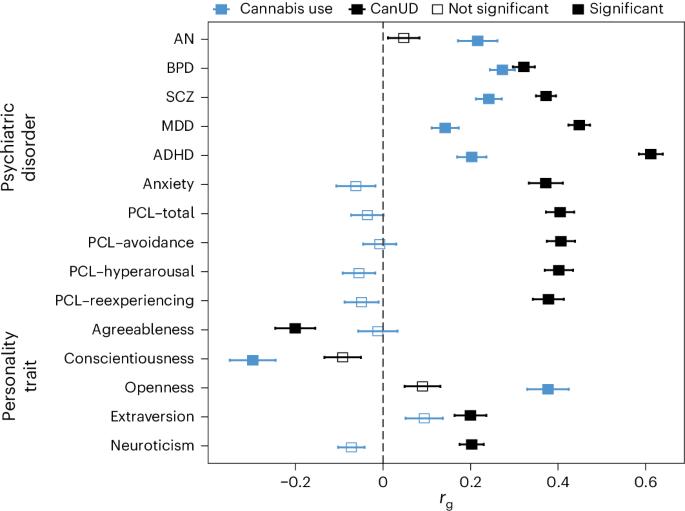The genetic relationship between cannabis use disorder, cannabis use and psychiatric disorders
IF 8.7
引用次数: 0
Abstract
Increasing prevalence of cannabis use and cannabis use disorder (CanUD) may increase risk for psychiatric disorders. We evaluated the relationships between these cannabis traits and a range of psychiatric traits, running global and local genetic correlations, genomic structural equation modeling, colocalization analyses and Mendelian randomization analyses for causality. Global genetic analyses identified significantly different correlations between CanUD and cannabis use. A variant in strong linkage disequilibrium to one regulating CHRNA2 was significantly shared by CanUD and schizophrenia in colocalization analysis and included in a significant region in local genetic correlations between these traits. A three-factor model from genomic structural equation modeling showed that CanUD and cannabis use partially map together onto a factor with major depressive disorder and ADHD. In terms of causality, CanUD showed bidirectional causal relationships with most tested psychiatric disorders, differently from cannabis use. Increasing use of cannabis can increase rates of psychiatric disorders over time, especially in individuals who progress from cannabis use to CanUD. This genetic study utilizing the newest available GWAS summary statistics provides evidence on the relationship between cannabis use, cannabis use disorder and a range of psychiatric disorders.

大麻使用障碍、大麻使用与精神障碍之间的遗传关系
大麻使用和大麻使用障碍(CanUD)的日益流行可能增加精神疾病的风险。我们评估了这些大麻特征与一系列精神特征之间的关系,运行全局和局部遗传相关性,基因组结构方程模型,共定位分析和孟德尔随机化因果关系分析。全球遗传分析发现,CanUD和大麻使用之间存在显著不同的相关性。在共定位分析中,CanUD和精神分裂症显著共享一个与调节CHRNA2的强连锁不平衡的变异,并在这些性状之间的局部遗传相关中包含一个重要区域。基因组结构方程模型的三因素模型表明,CanUD和大麻使用部分映射到重度抑郁症和多动症的一个因素上。在因果关系方面,CanUD与大多数测试的精神疾病表现出双向因果关系,这与大麻使用不同。随着时间的推移,越来越多地使用大麻会增加精神疾病的发病率,特别是那些从使用大麻发展到吸食大麻的人。这项利用最新可用的GWAS摘要统计数据的遗传研究为大麻使用、大麻使用障碍和一系列精神疾病之间的关系提供了证据。
本文章由计算机程序翻译,如有差异,请以英文原文为准。
求助全文
约1分钟内获得全文
求助全文

 求助内容:
求助内容: 应助结果提醒方式:
应助结果提醒方式:


